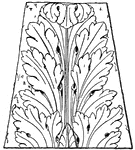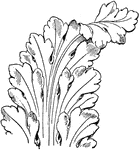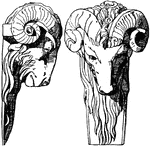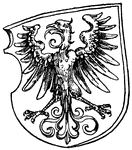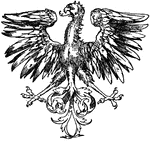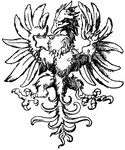
Temple of Vesta, Tivoli
The circular so-called "Temple of Vesta" at Tivoli, of the early first century BCE, has been widely…

Section of the Dome of Duomo, Florence
The Basilica di Santa Maria del Fiore is the cathedral church (Duomo) of Florence, Italy, begun in 1296…
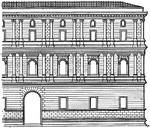
Façade of the Giraud Palace, Rome
In the Giraud Palace and the great Palazzo della Cancelleria, pilasters appear in the external composition,…

Plan of Farnese Palace
Palazzo Farnese is a prominent High Renaissance palace in Rome, which currently houses the French Embassy…

Plan of Château de Chambord
The royal Château de Chambord at Chambord, Loir-et-Cher, France is one of the most recognizable…

Plan of Louvre and Tuileries, Paris
The palais du Louvre in Paris, on the Right Bank of the Seine is a former royal palace, situated between…
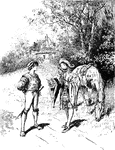
Two Men Talking
Two men in renaissance clothing having a conversation on the side of the road. The man to the left is…
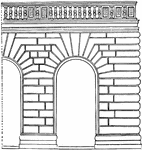
Rustication
"Rustication was first treated systematically by the architects of the Renaissance in Tuscany, especially…
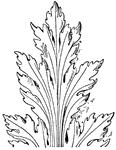
French Leaf Renaissance
The French Renaissance Leaf design tend to look more formal. This design was found in a church in Epernay…

Renaissance Ornament
The Renaissance Ornament is a relief on the tomb of Hieronimo Basso, St. Maria del Popolo, Rome, by…

Renaissance Ornament Vine
The Renaissance Ornament Vine was used as a design on an Italian pilaster.

Renaissance Ornament Vine
The Renaissance Ornament Vine is a frieze design found in Venice, Italy in the 16th century.

Libreria Cluster
The Libreria Cluster is a fruit Festoon design found in the Cathedral of Siena, Italy during the Italian…
Tomb of Louis XVII Cluster
The Tomb of Louis XVII Cluster is a fruit Festoon design found in St. Denis, France during the French…

Tomb of Cardinal Della Rovere Festoon
The Tomb of cardinal Della Rovere Festoon is garland design found in Maria del Popolo, Rome during the…

Tomb of Beatrice and Lavinia Ponzetti Festoon
The Tomb of Beatrice and Lavinia Ponzetti Festoon is a leaf festoon found in St. Maria della Pace, Rome…

Lion Coat of Arms
This Lion Coat of Arms is designed with inlayed marble work. It was found in St. Croce, Florence, Italy,…

Lion Coat of Arms
This Lion Coat of Arms is designed with an intarsia panel. It was found in St. Maria Novella, Florence,…

Griffin Renaissance
The Renaissance Griffin is associated with Antiquity and fire, it appears on Candelabras and friezes.…
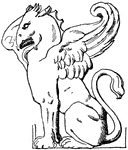
Sitting Griffin
The Sitting Griffin is used as a support of a seat in the Castle of Gaillon during the French Renaissance.

Castle at Blois Dolphin
The Castle at Blois Dolphin is a design found at the Castle in Blois, France during the French Renaissance.
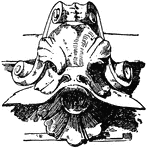
Dolphin Head
This Dolphin Head is shown in the form of a spout, designed during the Italian Renaissance.

Dolphin Head
This Dolphin Head is shown in the form of a spout, designed during the Italian Renaissance.
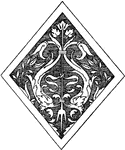
Dolphin Choir Seats
The Dolphin Choir Seats are found in Certosa near Pavia an ancient Italian town. It was designed during…

Dolphin Frieze
The Dolphin Frieze is a part of a larger frieze found in Rome at the Arco della chiesa nuovo (the arc…
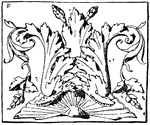
Dolphin Lower Panel
The Dolphin Lower Panel is found in the Ducal Palace in Venice, Italy during the Italian Renaissance.
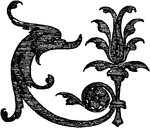
Dolphin Majolica Tile
The Dolphin Majolica Tile is found in St. Caterina in Siena, Italy during the Italian Renaissance.
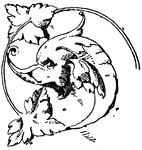
Dolphin Head
This Dolphin Head was designed in a Cathedral in Limoges, France during French Renaissance.

Dolphin Handle Vessel
The Dolphin Handle Vessel is a pilaster designed by Benedetto da Majano during the Italian Renaissance.
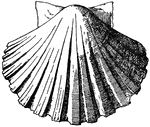
Exterior Scallop Shell
The Exterior Scallop Shell was used as a water basin in the form of a shallow dish and as a decorative…
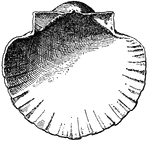
Interior Scallop Shell
The Interior Scallop Shell was used as a water basin in the form of a shallow dish and as a decorative…

Scallop Design Shell
This Scallop Design Shell was used as a decoration of a niche. A design commonly used during the Late…
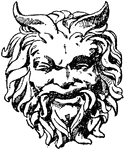
Satyr Mask
The Satyr Mask (Greek Mythological character) was designed during the Italian Renaissance by Sansovino,…

Grotesque Mask
The Grotesque mask is a Venetian Italian Renaissance design. It was often place on keystones, consoles,…
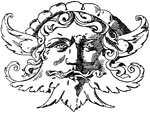
Grotesque Mask
This Grotesque mask was designed during the Italian Renaissance, by Sansovino. It is found on the tomb…
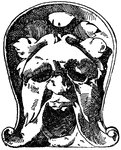
Single Grotesque Mask
The Single Grotesque mask comes from a frieze design during the Italian Renaissance. It was designed…

Pilaster Grotesque Mask
The Pilaster Grotesque mask comes from a part of a capital pilaster of the tomb of Louis XII in St.…
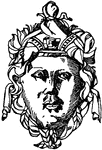
Female Grotesque Mask
The Female Grotesque mask was designed on a metal shield during the German Renaissance.

Female Grotesque Mask
The Female Grotesque mask was designed on a metal shield during the German Renaissance.

Rounded Grotesque Mask
This Grotesque Mask was designed by Michelangelo during the Italian Renaissance.

Pulled Grotesque Mask
This Pulled Grotesque Mask is on a pedestal of a column on a tomb in Pforzheim, Germany during the German…

Winged Grotesque Mask
This Winged Grotesque mask design comes from the spout of a can during the German Renaissance.

Melting Grotesque Mask
This Melting Grotesque Mask has an escutcheon design of a lock during the German Renaissance.

Grotesque Pilaster
The Grotesque pilaster is a squatting winged female without arms. It was designed during the Italian…
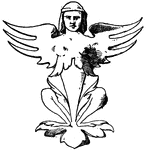
Winged Grotesque Pilaster
The Winged Grotesque pilaster is a squatting winged female without arms. It is found on the tomb of…

Flying Grotesque Pilaster
This Flying Grotesque pilaster is a squatting winged female without arms. It is found in a palace in…
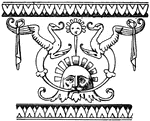
Grotesque Italian Majolica
The Italian Majolica Grotesque is designed on a pavement, made out of fine italian glazed earthenware.…

Tall Grotesque Stall
The Tall Grotesque stall is found in San Severino, Naples, Italy. It is a design of a winged female…
